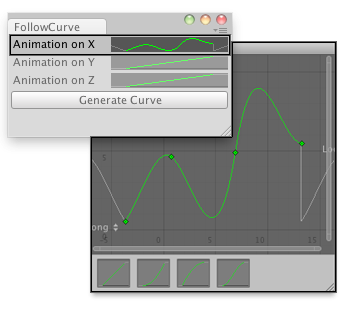EditorGUILayout.CurveField
Cambiar al Manualpublic static AnimationCurve CurveField
(string label,
AnimationCurve value,
params GUILayoutOption[] options);
public static AnimationCurve CurveField
(GUIContent label,
AnimationCurve value,
params GUILayoutOption[] options);
public static AnimationCurve CurveField
(AnimationCurve value,
Color color,
Rect ranges,
params GUILayoutOption[] options);
public static AnimationCurve CurveField
(string label,
AnimationCurve value,
Color color,
Rect ranges,
params GUILayoutOption[] options);
public static AnimationCurve CurveField
(GUIContent label,
AnimationCurve value,
Color color,
Rect ranges,
params GUILayoutOption[] options);
Parámetros
| label | Optional label to display in front of the field. |
| value | The curve to edit. |
| color | The color to show the curve with. |
| ranges | Optional rectangle that the curve is restrained within. |
| options | An optional list of layout options that specify extra layout properties. Any values passed in here will override settings defined by the style.See Also: GUILayout.Width, GUILayout.Height, GUILayout.MinWidth, GUILayout.MaxWidth, GUILayout.MinHeight, GUILayout.MaxHeight, GUILayout.ExpandWidth, GUILayout.ExpandHeight. |
Valor de retorno
AnimationCurve The curve edited by the user.
Descripción
Make a field for editing an AnimationCurve.

Create an animation on the different axis and assign it to a GameObject.
using System.Collections; using System.Collections.Generic; using UnityEngine; using UnityEditor;
public class FollowCurve : EditorWindow { AnimationCurve curveX = AnimationCurve.Linear(0, 0, 10, 10); AnimationCurve curveY = AnimationCurve.Linear(0, 0, 10, 10); AnimationCurve curveZ = AnimationCurve.Linear(0, 0, 10, 10);
[MenuItem("Examples/Create Curve For Object")] static void Init() { FollowCurve window = (FollowCurve)EditorWindow.GetWindow(typeof(FollowCurve)); window.Show(); }
void OnGUI() { curveX = EditorGUILayout.CurveField("Animation on X", curveX); curveY = EditorGUILayout.CurveField("Animation on Y", curveY); curveZ = EditorGUILayout.CurveField("Animation on Z", curveZ);
if (GUILayout.Button("Generate Curve")) AddCurveToSelectedGameObject(); }
void AddCurveToSelectedGameObject() { if (Selection.activeGameObject) { FollowAnimationCurve comp = Selection.activeGameObject.AddComponent<FollowAnimationCurve>();
comp.SetCurves(curveX, curveY, curveZ); } else { Debug.LogError("No Game Object selected for adding an animation curve"); } } }
And the script that works with the example:
using UnityEngine; using System.Collections;
public class FollowAnimationCurve : MonoBehaviour { public AnimationCurve curveX; public AnimationCurve curveY; public AnimationCurve curveZ;
public void SetCurves(AnimationCurve xC, AnimationCurve yC, AnimationCurve zC) { curveX = xC; curveY = yC; curveZ = zC; }
void Update() { transform.position = new Vector3(curveX.Evaluate(Time.time), curveY.Evaluate(Time.time), curveZ.Evaluate(Time.time)); } }
public static void CurveField
(SerializedProperty property,
Color color,
Rect ranges,
params GUILayoutOption[] options);
public static void CurveField
(SerializedProperty property,
Color color,
Rect ranges,
GUIContent label,
params GUILayoutOption[] options);
Parámetros
| property | The curve to edit. |
| color | The color to show the curve with. |
| ranges | Optional rectangle that the curve is restrained within. |
| options | An optional list of layout options that specify extra layout properties. Any values passed in here will override settings defined by the style.See Also: GUILayout.Width, GUILayout.Height, GUILayout.MinWidth, GUILayout.MaxWidth, GUILayout.MinHeight, GUILayout.MaxHeight, GUILayout.ExpandWidth, GUILayout.ExpandHeight. |
| label | Optional label to display in front of the field. Pass [[GUIContent.none] to hide the label. |
Descripción
Make a field for editing an AnimationCurve.
Copyright © 2020 Unity Technologies. Publication 2019.3